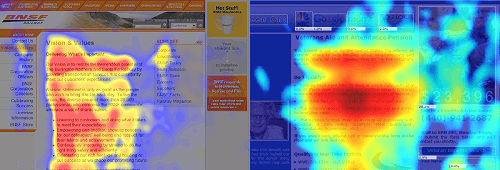Usability studies have been and continue to be a key method for testing and optimizing website usability. Both laboratory eye tracking and remote mouse tracking studies offer businesses accurate and actionable results.
Eye tracking, as used by top enterprises such as Google, uses cameras and specialist software to track where the eyes of internet users land on a webpage. Mouse tracking analytics follows the mouse movements of an internet user to simulate eye movement on a webpage. Over the last few years, mouse tracking has greatly matured, developing features and achieving accuracy that make it an excellent alternative to eye tracking.

Image 1 Heatmaps created using traditional eye tracking (left) and mouse tracking (right)
Research has shown that when both testing methods are conducted simultaneously, there is an 84%-88% correlation in the results1. Eye and mousetracking follow similar rhythms and focus on the same page content. Both eye and mouse tracking analytics deliver valuable information about how your visitors engage with your website. This is vital to work out how to optimize the site to improve your visitors’ experience and ROI.

Image 2 Example of the mouse following the eye in the vertical direction on a google search page, plotting the Y coordinate against time. Google, 2008
PROS & CONS
As with any process, each method of testing has advantages and disadvantages.
Eye Tracking Analytics
|
Advantages
|
Disadvantages
|
|
100% accuracy. Find out exactly what the testers look at on the page.
Controlled environment. Your visitors are asked to carry out pre-determined tasks. You can therefore define exactly what to test and know the objectives of your testers.
Open dialogue. Visitors can give in-depth feedback and answer any questions you may have, removing the guesswork regarding visitor motive and satisfaction.
|
Cost. Comes with an extremely hefty price tag, requiring specialist equipment and staff. The cost can increase with more participants and higher frequency of testing.
Limited scope. The number of participants, screen size measurements, and variety of participants is limited. Your data results are based on a small sampling of unique visitors.
Strong observer effect. Visitors know that their every move is being monitored, therefore cannot be expected to act naturally. High chance of the Hawthorne effect.
|
Mouse Tracking Analytics
|
Advantages
|
Disadvantages
|
|
Natural environment. Tests take place in the visitors’ own home or office, providing accurate usability results with a wide array of browsers/operating systems/screen sizes.
No observer effect. Visitors navigate your website naturally, completely unaware they are being tested.
Global participation. Test visitors from all over the world. As long as traffic is coming to your site, you can test continually.
Low Cost. Mouse tracking analytics costs a fraction of the cost of eye tracking, and requires no specialist equipment or skills.
|
No pre-defined tests. You cannot specify what you would like to test. You have to rely on the visitors’ own objectives.
No research control. You cannot change or control the environment in which the tests take place.
No visitor feedback. You cannot ask your visitors direct questions about their experiences, and cannot know exactly what they are thinking.
|
There is still some measure of debate between eye and mouse tracking camps regarding the value of gauging subconscious thought versus that of actionable intent. Eye tracking does capture significantly more involuntary eye movement than mouse tracking, providing a window into a visitor’s subconscious. However, the mouse tracking camp contends that for many websites, it is more valuable to understand customers’ intent rather than their subconscious behavior, which is open to subjective and possibly misleading interpretation. Let us know what you think about this debate in the comments below.
WHAT SHOULD I USE?
In an ideal world, every website would use both eye and mouse tracking analytics, as each method delivers valuable and actionable information. Research conducted by Google2 concluded by recommending that BOTH mouse and eye tracking should be used when evaluating and optimizing website usability. However, few enterprises can afford to conduct regular eye tracking studies on their websites, or net sufficient ROI to justify the cost. This is therefore not a viable option for small or mid-size businesses, which should still rely on inexpensive and frequent mouse tracking studies, and may not be appropriate for many enterprises.
For marketing, product and e-commerce managers, it’s crucial to know what visitors think of your websites. Insight into visitor engagement — or lack of engagement — with the various site elements is essential information for improving your website, to benefit both customers and your own bottom line.
Contact us to learn more about how mouse analytics can give you valuable insight into customer experience on your site.
References / further reading
1 https://portal.acm.org/citation.cfm?id=634234
2 https://research.microsoft.com/en-us/um/people/ryenw/proceedings/WISI2007.pdf – page 29
Clicktale was acquired by Contentsquare in 2019. Since then, tools and features mentioned in this blog may have evolved. Learn more about our Digital Experience Analytics Platfor